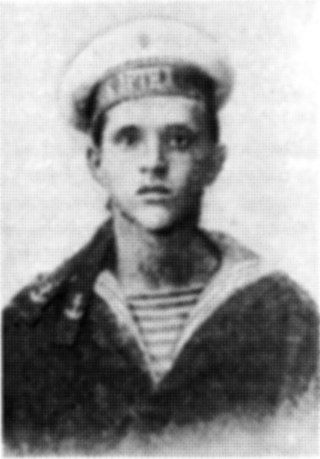
Peter Andreyevich Arshinov, was a Russian anarchist revolutionary and intellectual who chronicled the history of the Makhnovshchina.

Dmitry Ivanovich Popov was a Russian sailor and Left Socialist-Revolutionary that led the Left SR uprising against the Bolsheviks in July 1918. Following the suppression of the uprising, he joined the Revolutionary Insurgent Army of Ukraine and became a leading member, spearheading the negotiations between the Makhnovists and the Bolsheviks until his arrest and execution by the Cheka.
The Makhnovshchina was a mass movement to establish anarchist communism in southern and eastern Ukraine during the Ukrainian War of Independence of 1917–1921. Named after Nestor Makhno, the commander-in-chief of the Revolutionary Insurgent Army of Ukraine, its aim was to create a system of free soviets that would manage the transition towards a stateless and classless society.

Viktor Fedorovych Bilash was the Chief of Staff of the Revolutionary Insurgent Army of Ukraine (RIAU) under Nestor Makhno. A gifted military commander, Bilash himself planned many of the Insurgent Army's operations, later becoming its commander in chief after Makhno's flight into exile.

Semen Mykytovych Karetnyk was a Ukrainian anarchist and a commander of the Revolutionary Insurgent Army of Ukraine (RIAU). He often replaced Nestor Makhno as supreme commander of the Black Army in 1920. Karetnyk gained a reputation for his central role in defeating the White Army in Crimea in November 1920.

The Cause of Labor was a libertarian communist magazine published by exiled Russian and Ukrainian anarchists. Initially under the editorship of Peter Arshinov, after it published the Organizational Platform, the subsequent controversy resulted in his exit from the anarchist movement. The magazine was then picked up by Grigorii Maksimov, who moved it to the United States and edited it until his death in 1950.

Lev Mykolaiovych Zadov, also known by his nom de guerreLev Zinkovskyi, was chief of military intelligence of the Revolutionary Insurgent Army of Ukraine (RIAU) and later an operative of the Joint State Political Directorate (OGPU).
The Nabat Confederation of Anarchist Organizations, better known simply as the Nabat, was a Ukrainian anarchist organization that came to prominence during the Ukrainian War of Independence. The organization, based in Kharkiv, had branches in all of Ukraine's major cities. Its constitution was designed to be appealing to each of the different anarchist schools of thought.
Free soviets were the basic form of organization in the Makhnovshchina. These soviets acted independently from any central authority, excluding all political parties from participation, and met to self-manage the activities of workers and peasants through participatory democracy.

Agafya "Halyna" Andriivna Kuzmenko was a Ukrainian teacher and anarchist revolutionary. After moving to southern Ukraine, she became a prominent figure within the ranks of the Makhnovshchina, a mass movement to establish a libertarian communist society. Kuzmenko spearheaded the movement's educational activities, promoted Ukrainization and acted as an outspoken advocate of women's rights. Along with her husband, the anarchist military leader Nestor Makhno, in 1921 she fled into exile from the political repression in Ukraine. While imprisoned for subversive activities in Poland, she gave birth to her daughter Elena Mikhnenko, whom she brought with her to Paris. Following the death of her husband, the outbreak of World War II saw her deportation for forced labour, first by the Nazis and then by the Soviets. After her release, she spent her final days with her daughter in Kazakhstan.
Oleksandr Kalashnykov was a Ukrainian anarchist and a commander of the 1st Donetsk Corps of the Revolutionary Insurgent Army of Ukraine.
Mikhail Uralov was a Russian anarchist, the head of the "Black Guard" combat units of the Moscow Federation of Anarchists ,and a commander of the Revolutionary Insurgent Army of Ukraine.
Oleksiy Vasylovych Chubenko was a diplomat for the Revolutionary Insurgent Army of Ukraine.

The Military Revolutionary Council was the de facto executive of the Makhnovshchina, empowered to act during the interim between sittings of the Regional Congresses.

The Regional Congresses of Peasants, Workers and Insurgents represented the "highest form of democratic authority" within the political system of the Makhnovshchina. They brought together delegates from the region's peasantry, industrial workers and insurgent soldiers, which would discuss the issues at hand and take their decisions back with them to local popular assemblies.

The flags of the Makhnovshchina consisted of a number of different black and red flags, each emblazoned with anarchist and socialist slogans.

Vasyl Kurylenko was a commander in the Revolutionary Insurgent Army of Ukraine.
Yosif Isaakovich Gotman, also known by his nom de plureYosif the Emigrant, was a Ukrainian anarchist and a leading member of the Nabat and the Makhnovshchina.
The Road to Freedom was the main newspaper of the Makhnovist movement, publishing 50 issues from May 1919 to November 1920.
Iliya Hordev, commonly known as Isaac Teper, was a Ukrainian Jewish anarchist, who became a leading member of the Nabat and the Makhnovist movement in 1920. His account of the movement's history, published in 1924, provided a key primary source for historiography about the movement.












